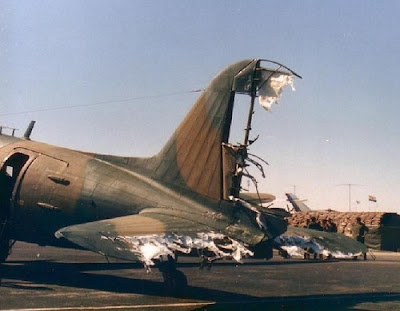Readers may remember that ten years ago, I published an article about a South African Air Force C-47 transport that was hit by a SA-7 missile over what was then South West Africa (today Namibia) during the Border War. Despite severe damage to the aircraft, the pilot managed to land it safely, and all aboard survived without injury.
I was pleased to find that a couple of months ago, the "World War II After World War II" blog published a long and interesting article about the same incident, starting with an analysis of the development of early man-portable air defense systems (MANPADS), then a look at Soviet anti-aircraft missiles in Africa, and finally (about two-thirds of the way down) a detailed examination of the C-47 incident. Here's an excerpt.
In August 1986 a South African C-47 Skytrain was flying high-ranking officers (including a senior general) to Ondangwa airbase in SWA. This was a very northern airbase, about 35 miles south of the Angolan border. While at 8,000′ and normal cruising speed, the plane was rocked by a large explosion to the rear and the pilot began to lose control of pitch.
The C-47’s loadmaster looked out and reported that much of the tail appeared to be gone, with the fabric of the elevators flapping in the slipstream. The pilot declared an emergency to Ondangwa. At the airbase, an Alouette III helicopter took off to meet the plane.
Availability of the helicopter and its observations were a great benefit to the plane’s safe recovery. The helicopter radioed the C-47 that the rudder was entirely gone, as was most of both the left and right elevators. He also let him know that the tailwheel was still intact and the rear fuselage was structurally sound, meaning a normal landing could still be attempted.
At this point there were still portions of the elevators near the outboard hinges partially intact, but rapidly disintegrating. Having already descended to low altitude, the pilot slowed to 100 kts to delay their continuing shredding by the slipstream.
. . .
The most pressing concern was pitch control with no elevators. The loadmaster instructed the VIP passengers to move around the cabin. While the idea of top brass running around the inside of a plane is possibly humorous, it was effective. Shifting weight front/rear moved the plane’s imaginary lifting point around, which had the effect of the nose either rising or falling. This (very crudely) imitated the role the elevators would normally do.
There's much more at the link, with plenty of photographs. It's a long, complex article covering many areas, and will be of interest to aviation technology and military history buffs.
It brought back many memories to read the article, particularly the use of captured Soviet MANPADS by South African special forces. I wrote a fictional account about some of that in my story "Unintended Consequences", published in the anthology "Trouble In The Wind" a few years ago. (I published a snippet from it on this blog earlier this year.)
There were many facts and recollections informing that fictional tale!
Peter


Those old C-47s were tough birds! And yes, ANYTHING can change the CG and attitude. Of course the 'timing' of those changes can get interesting at times...
ReplyDeleteWhat probably helped more is the trim is control by the stabilizer on that aircraft which gave the pilot some pitch control.
ReplyDeletePeter, I do believe a couple of "Santa Maria's" onboard had added brown markings after that episode!
ReplyDeleteI was not aware that parts of the C-47 were fabric covered. I had thought that it was all metal.
ReplyDeleteWe did a similar thing on Dolphin AGSS555. When diving a badly calculated trim was compensated for by 10 or more crew to "sally ship fwd or sally ship aft" until proper trim could be made. Fun times...
ReplyDelete